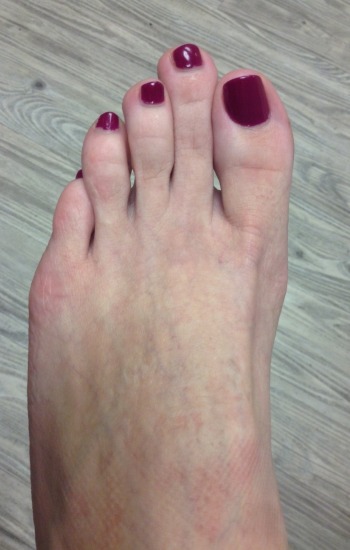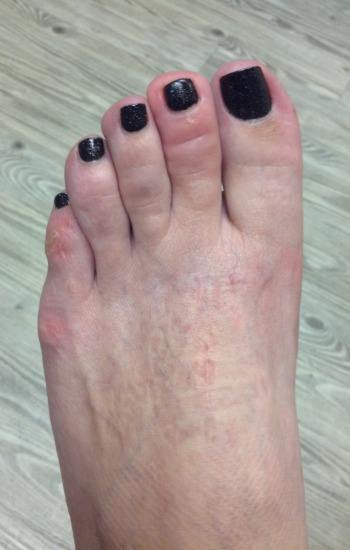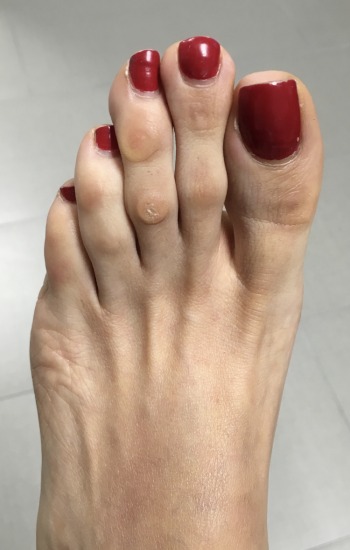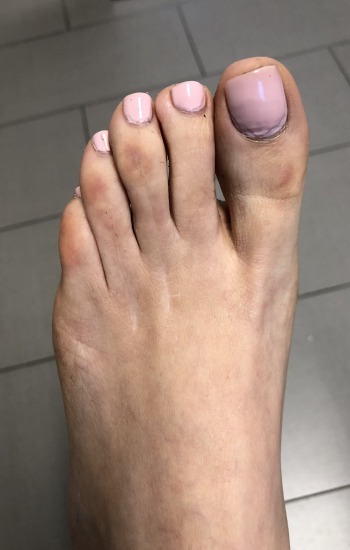When seeking treatment for foot pain, choose a Board Certified Podiatrist with a successful track record of foot and ankle surgery and treatment for patients.
Reconstructive Foot & Ankle Surgery by Podiatrist Dr. Vladimir Zeetser
Reconstructive Foot and Ankle surgery is aimed at correcting structural deformities, whether congenital or acquired, to restore function and eliminate or reduce pain. This is distinguished from aesthetic surgery, which is typically performed to correct deformities for cosmetic reasons that are not currently painful.
Dr. Zeetser performs all aspects of reconstructive foot and ankle surgery, ranging from minor to very complex. He treats patients of all ages, including children, adults and the elderly. He combines state of art implants and fixation devices with the latest and most innovative procedures available today.
The most common procedures he performs are:
- Bunion Correction
- Advanced Modified Mini-TightRope Bunion Surgery
- Hammertoe Correction
- Hallux Limitus/Rigidus (stiff big toe) Correction with or without implant arthroplasty
- Tailor's Bunion Correction
- Flatfoot Correction with or without implant
- Ball of the Foot Pain Correction (Metatarsal pain)
- Foot and Ankle Arthritis Repair
- Trauma Surgery for fractures, tendon and soft tissue tears
Additional Services Include:
- Aesthetic procedures
- Custom Orthotics, braces and splints
- Heel pain and Plantar Fasciitis treatment including surgery with non-invasive Extracorporeal Shockwave Therapy (ESWT)
- TOPAZ Procedure for Achilles tendon injuries and Plantar fasciitis
- Viscosupplementation with injections of synthetic joint fluid to treat arthritis
- Bone spurs
- Ingrown toenail surgical correction
- Neuroma treatment
- Plantar Wart treatment
- Platelet Rich Plasma (PRP) for tendon injuries
- Skin and Nail treatment for corns, calluses, rashes and infections, including fungal nails
- Sports Medicine for the treatment of ankle sprains, foot sprains and tendonitis
- Lower Extremity Swelling Control
- Varicose and spider veins
- Infrared Light Therapy (Anodyne) for Neuropathy and musculoskeletal pain
- Physical Therapy for the lower extremity
- Second opinions
- Wound care and Limb Salvage
Advanced Modified Mini-TightRope Bunion Surgery
Dr. Zeetser is an expert in the field of Bunion Correction Repair Surgery, and utilizes several different techniques to achieve the perfect outcomes for his patients.
The treatment of hallux valgus deformity includes the assessment of the hallux valgus angle, the intermetatarsal angle and the contribution of an interphalageus deformity. Additionally, there must be an assessment of the presence or absence of arthritic involvement of both the first metatarsocuneiform joint and the first metatarsophalangeal joint. Other considerations are the orientation of the distal metatarsal articular angle and the orientation and stability of the first metatarsocuneiform joint.
Contact Dr. Zeetser today for a Bunion Correction consultation by calling 818-907-6100
Aesthetic Toe Shortening
Excessively long lesser toes are a relatively common deformity and typically pose a cosmetic concern for women more often than men. Commonly referred to as "raptor toe", when the toe hangs off the edge of an open toed shoe, the most prevalent of excessively long toes is the 2nd digit, which is adjacent to the big toe. Normally, the big toe is roughly equal in the length to the 2nd and possibly 3rd, followed by the 4th and 5th to create what is known as the tip-toe parabola. A small percentage of the population suffers from a disruption of this parabola leading to this unsightly condition, as well as shoe fitting problems.
The aesthetic appearance of the toe often leads to its own array of psychological and social issues. Imagine being ridiculed in school as a teen-ager or being embarrassed to wear open toed sandals. Young females typically become very self-conscious about their feet and tend to shy from social activities that would expose them. But far from being simply a cosmetically displeasing deformity, this condition can result in further deformity and deterioration of the toe. Because the longest toe suffers from repetitive microtrauma in closed shoes, the most common result is a hammertoe contracture of the toe and bending of the tip of the toe with most of the weightbearing occurring at the tip rather than the fatty bottom of the toe. As a result, the nail suffers constant damage and often becomes darkened and thickened from fungal infection. The joints on the dorsum (top) of the toe typically rub and become irritated from the top of the shoe, causing unsightly corns, blisters, scarring, pain and occasionally open wounds.
There is no practical or long term method to manage this problem without surgery, especially if shoe fashion is a priority.
Fortunately, all hope is not lost. Dr. Zeetser is at the forefront of innovative and progressive surgical procedures that can effectively correct this condition using state of art digital implants which usually do need to be removed. Generally the procedure is performed at the level of the toe, but occasionally depending on other structural factors, a more extensive procedure may be required. This is evaluated on a case by case basis. With little to no visible scarring and minimal to no pain, the procedure can be done in an outpatient setting and the patient is ambulatory immediately after. Recovery times are much shorter which let you get active and back into shoes faster. In contrast, the older traditional ways of performing the procedure involve the use of a metal wire protruding from the tip of toe for at least 4 weeks. Not only does this prevent the patient from being able to properly bathe for a prolonged period of time, but there are issues associated with the wires including increased risk of infection, damage to the externally protruding wires by accident and the need to later remove the wires.
Aesthetic Toe Shortening

Female A Before Surgery

Female A After Surgery

Female B Before Surgery

Female B 2 Months After
Aesthetic Toe Lengthening
Isolated short toes can be a problem which is aesthetically displeasing and lead to many similar social and functional issues as with excessively long toes. The cause of the condition can be congenital or acquired. Depending on the cause, a procedure can now be performed to improve the aesthetic appearance of the toe and restore its length.
Because no two feet are alike, each patient deserves individualized attention and a procedure geared towards their specific situation and goals may be proposed.
Aesthetic Toe Debulking "Toe-Tuck"
As with all aesthetic procedures, they are merely refinements of time tested techniques. Hammertoe corrections can be performed with the intention of eliminating pain, reducing deformity or preventing future complications. Often times, with this goal in mind, the result is less than aesthetic with bunched up skin and folds, leaving the toe looking thick and stubby. Patients are usually told that this skin will contract and resorb with time, which may or may not occur over years. Disregard for aesthetics and lack of attention to detail is the real cause. This is what differentiates the average surgeon from an aesthetic foot surgeon.
Because no two feet are alike, each patient deserves individualized attention and a procedure geared towards their specific situation and goals may be proposed.
Aesthetic Hammertoe Correction
Hammertoes and their related deformities are unsightly contractures of the joints of the lesser toes, and occasionally the great toe as well. They typically occur from muscle and ligament imbalance and typically worsen from neglect. Besides being unpleasant to look at and causing difficulty with fitting into stylish shoes, these deformities tend to be progressive with time and lead to further disfigurement of the foot and suffering. Often times, they result in dislocation of the metatarsophalangeal joint (where the ball of foot meets the base of the toe) with crossover toe deformity. Furthermore, excessive hammertoe contractures cause excessive pressure on the plantar aspect of the ball of the foot, causing additional complications and pain. Besides the structural problems and inflammation that they can cause, hammertoes typically produce painful and unsightly bursal sacs, corns and calluses at the affected joints. Conservative treatment is an option, but usually minimally successful. Early correction can be as simple a soft tissue release, however more advanced deformities typically require more advanced procedures which will be discussed in detail during the surgical consultation. The key is to create a pain-free, functional and aesthetic result rather than a floppy, fat and stubby toe as is commonly the case. Dr. Zeetser has been one successfully correcting these unsightly deformities with implants that are hidden within the toe and do not require later removal, unlike the case with percutaenous wires or pins protruding from the tip of the toe. Infection risk is reduced and the result is instant stability of the toe. Incision scars can be minimal to none.
Don't continue to live with hammertoes. Comfortably fitting into your favorite shoes doesn't have to be a memory. Reclaim your life and have beautiful, functional toes again!
Because no two feet are alike, each patient deserves individualized attention and a procedure geared towards their specific situation and goals may be proposed.
Aesthetic Fifth Toe Correction
The fifth or baby toe have a variety of deformities that are not only cosmetically unattractive, but can be a major source of discomfort and shoe fitting problems. Because it can get the most pressure and rubs directly inside shoes or sandal straps more than any other toe, the fifth toe can be one's sole source of foot problems and is termed "the tyranny of the little toe." Besides being unsightly, there is also often redness, bursitis, pain and thick corns. Destruction of the nail and fungal infection can occur. Often the toe is curved and underlapping the fourth toe with the nail directed to the outside, rather than upwards. Surgically correcting this deformity with a derotation of the toe can successfully improve the appearance and position of the toe. When the toe is rigidly contracted with a sharp bone spur or inflamed bursal sac, the toe becomes fat, painful and interferes with shoe wear. Aesthetic correction of toe can be performed to reduce the deformity and relieve the symptoms.
Because no two feet are alike, each patient deserves individualized attention and a procedure geared towards their specific situation and goals may be proposed.
Aesthetic Bunion Correction Expert
These are not merely unsightly bumps on the side of the foot. Bunions are the quiet joint killers. Although typically painful with redness and inflammation, this condition can have no symptoms for many years. During this time, the damage is being done as one of the most important joints in the foot becomes deteriorated and worn away. The cartilaginous joint surface that you are born with cannot be effectively replaced and technology to achieve this is still some time away. In the meantime, the cartilage is progressively eroded as the deformity continues to grow and pain usually follows. However, often the most disturbing aspect of this problem is the aesthetic appearance of the foot and inability to wear the desired shoes. Conservative treatment often includes wearing silicone bunion shields, wide unfashionable shoes and occasionally injections of anti-inflammatory medication. Unfortunately, since this is a fixed structural deformity, conservative care can only go so far and surgery is generally recommended. Most bunions become painful and irritate the foot inside shoes at some point and being proactive at preventing further deterioration is usually the best decision. When taking this into consideration, an aesthetic result is of major importance. Conventional bunion surgery has been performed for decades. Previously, little attention has been focused on the cosmetic result, consideration for the patient's ease of recovery and post-operative pain. Using the state of art in fixation, aesthetic incision placement and modifications of time tested surgical techniques, Dr. Zeetser has been successfully performing these procedures and changing people's lives one foot at a time. Patient's typically can ambulate the same day. All fixation is hidden and does not usually need to be removed. Gone are the days of railroad track incision scars on the top of the big toe joint, having wires or pins protruding through the skin. Casts are almost never necessary and pain is minimal to none. Contrary to popular belief and what people may tell you, bunion surgery does not have to be painful and debilitating. Compare your result to the typical bunion surgery horror story!
Dr. Vladimir Zeetser is a board certified podiatric physician and surgeon specializing in reconstructive foot and ankle surgery. He is certified by the American Board of Podiatric Surgery both in Foot Surgery and Reconstructive Rearfoot and Ankle Surgery. His training includes advanced wound management and limb salvage and he has consistently achieved unparalleled results in healing problematic wounds. As an innovator and trendsetter in his field, he has been progressive in expanding aesthetic foot surgery and associated procedures to improve his patients' self-image while achieving among the highest functional outcomes and levels of patient satisfaction. Apparently unconventional in his practice approach, Dr. Zeetser believes that surgery should be minimally painful with a convenient and tolerable recovery, while producing the maximum results. He believes that the aesthetic result of any procedure is not a secondary consideration, but is just as important as the primary condition being corrected.
Dr. Zeetser treats all aspects of foot and ankle structural disorders, including lower extremity muscular, neurological, vascular and skin conditions. During your consultation, Dr. Zeetser always performs a thorough evaluation, explains his findings in detail and creates a treatment plan tailored to your specific needs. With all of your options presented in an understandable manner, you participate equally in the decision making for the treatment of your foot or ankle condition.




